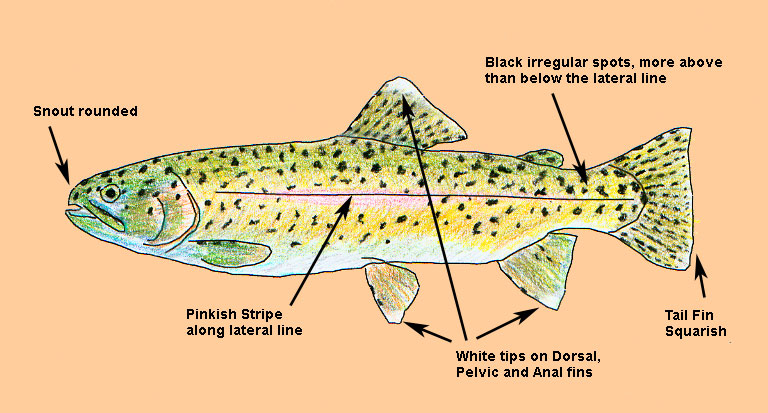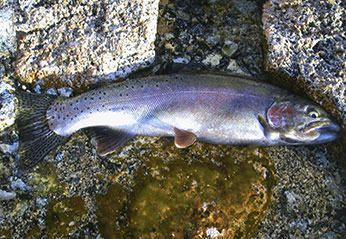Eagle Lake Rainbow Trout – tough as they come

 | |||
The Eagle Lake Rainbow Trout (Oncorhynchus mykiss aquilarum), is the only rainbow trout native to the east side of the Sierra. It was found only in Eagle Lake and it’s tributary Pine Creek in Lassen County. J.O. Snyder named this trout in 1917 using the latin name aguilarum, the latin term for Eagle. This trout is unique in it’s ability to withstand high alkalinity (Eagle Lake has a pH of 8.4 to 9.6). The trout have characteristics more similar to coastal rainbow and interior redband trout than the nearby Lahonton cutthroat. Since Pine Creek is only a few miles from the Pit River drainage, there is speculation that these trout may have developed from rainbows in this area. Eagle Lake has no outlet and the only place that the Eagle Lake trout can spawn is in Pine Creek. Over the years, the creek became intermittent within it’s lower reaches due to logging and grazing . The lush meadows of Pine Creek was transformed into sagebrush flats making spawning runs impossible to it’s headwaters. By 1950, the Eagle Lake Trout was considered to be on the brink of extinction. A trapping station was established by DFG at the mouth of Pine Creek. During the first year of trapping, six females and 3 males were collected to provide the first spawned eggs. Notes from this period indicate that only one female may have provided the initial eggs. Spawning FacilityToday the spawning facility at Crystal Lake Hatchery near Burney, CA provides over 2.3 million eggs each year. Brood stock of the Eagle Lake trout are also maintained at Mt. Shasta Hatchery where the fish are spawned artificially and about 4.2 million of eggs are sent to other state hatcheries around the state for rearing and stocking other Sierran Lakes and streams in addition to areas of New Zealand, Wyoming, and Montana. About 180,000 Eagle Lake trout are returned to Eagle Lake by this program. A restoration program of Pine Creek is being pursued to restore natural spawning since the hatchery rearing may be changing some of the original characteristics of the fish. Some of the activities include fencing the creek and improving passage through the channel sections of the stream. The DFG is also stocking some of the upper creek with Eagle Lake trout. A large population of brook trout reside within the upper reaches of Pine Creek that may be causing increased competition to the juvenile rainbows. The brooks may need to be eliminated in order to enable the success of a natural spawning program. Distinguishing Characteristics:The Eagle Lake Rainbow has a rounded nose. The fins and upper part of the body have large elongated spots. The irregularly-shaped spots decrease towards the belly. There is a pinkish stripe along the lateral line. The tail(caudal) fin edge is flat and has numerous, irregular spots. There is also a white tip on the dorsal, pelvic, and anal fins. J.O.Snyder described the following characteristics of the fish in 1917. Males at spawning time, “Body above and down the sides nearly to the lateral line is a rich dark olive, each scale brassy and very conspicuous. The sides below the olive region and the ventral surface are deep coppery-red with bright metallic reflections. The sides of the head are cherry-red, very rich in color. A trace of red beneath the mandible; iris brassy. The pectorals are broadly and conspicuously edged with olive.” Females at spawning time were described as “It is light olive above where each scale is silvery with greenish reflections. The sides are lighter, the scales more green than those above, the ventral surface silvery, tinted with pink. A very distinct pale reddish stripe extends along the side of the body, mostly below the lateral line. The cheeks and opercles are red, the iris orange. The ventrals and anal are suffused with red and distinctly edged with the same.” | |||

